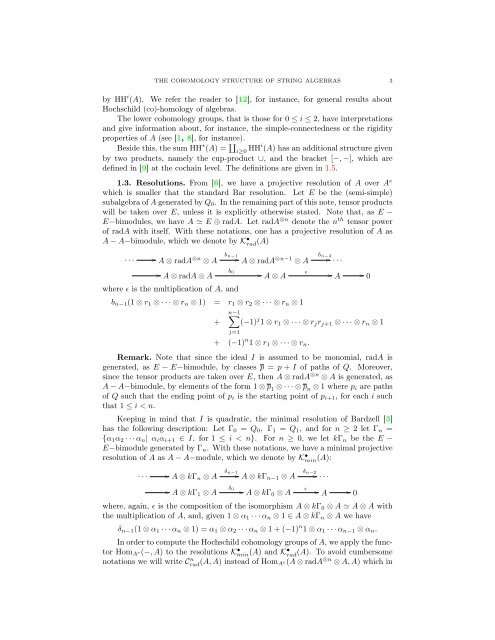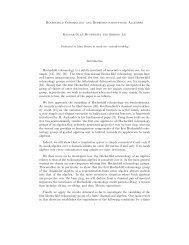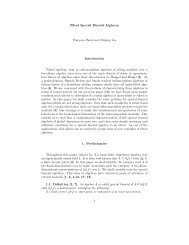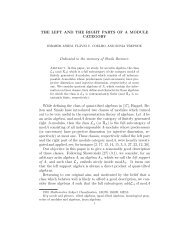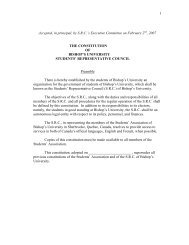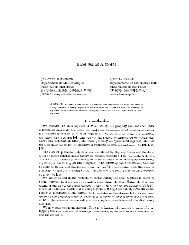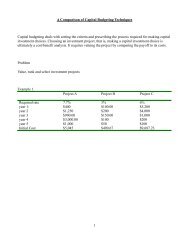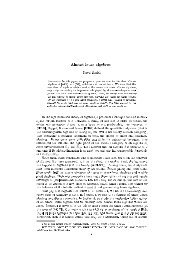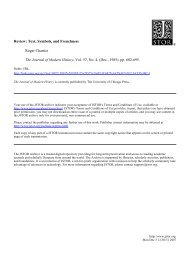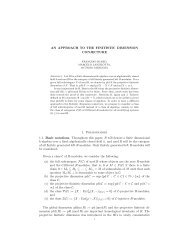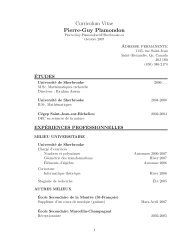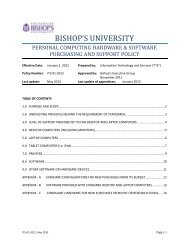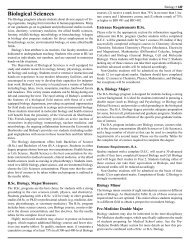The cohomology structure of string algebras
The cohomology structure of string algebras
The cohomology structure of string algebras
Create successful ePaper yourself
Turn your PDF publications into a flip-book with our unique Google optimized e-Paper software.
THE COHOMOLOGY STRUCTURE OF STRING ALGEBRAS 3<br />
by HH i (A). We refer the reader to [12], for instance, for general results about<br />
Hochschild (co)-homology <strong>of</strong> <strong>algebras</strong>.<br />
<strong>The</strong> lower <strong>cohomology</strong> groups, that is those for 0 ≤ i ≤ 2, have interpretations<br />
and give information about, for instance, the simple-connectedness or the rigidity<br />
properties <strong>of</strong> A (see [1, 8], for instance).<br />
Beside this, the sum HH ∗ (A) = ∐ i≥0 HHi (A) has an additional <strong>structure</strong> given<br />
by two products, namely the cup-product ∪, and the bracket [−, −], which are<br />
defined in [9] at the cochain level. <strong>The</strong> definitions are given in 1.5.<br />
1.3. Resolutions. From [6], we have a projective resolution <strong>of</strong> A over A e<br />
which is smaller that the standard Bar resolution. Let E be the (semi-simple)<br />
subalgebra <strong>of</strong> A generated by Q 0 . In the remaining part <strong>of</strong> this note, tensor products<br />
will be taken over E, unless it is explicitly otherwise stated. Note that, as E −<br />
E−bimodules, we have A ≃ E ⊕ radA. Let radA ⊗n denote the n th tensor power<br />
<strong>of</strong> radA with itself. With these notations, one has a projective resolution <strong>of</strong> A as<br />
A − A−bimodule, which we denote by K<br />
rad • (A)<br />
. . . A ⊗ radA ⊗n ⊗ A bn−1 A ⊗ radA ⊗n−1 ⊗ A bn−2 . . .<br />
A ⊗ radA ⊗ A<br />
where ɛ is the multiplication <strong>of</strong> A, and<br />
b 0<br />
A ⊗ A<br />
b n−1 (1 ⊗ r 1 ⊗ · · · ⊗ r n ⊗ 1) = r 1 ⊗ r 2 ⊗ · · · ⊗ r n ⊗ 1<br />
+<br />
ɛ<br />
A 0<br />
n−1<br />
∑<br />
(−1) j 1 ⊗ r 1 ⊗ · · · ⊗ r j r j+1 ⊗ · · · ⊗ r n ⊗ 1<br />
j=1<br />
+ (−1) n 1 ⊗ r 1 ⊗ · · · ⊗ r n .<br />
Remark. Note that since the ideal I is assumed to be monomial, radA is<br />
generated, as E − E−bimodule, by classes p = p + I <strong>of</strong> paths <strong>of</strong> Q. Moreover,<br />
since the tensor products are taken over E, then A ⊗ radA ⊗n ⊗ A is generated, as<br />
A − A−bimodule, by elements <strong>of</strong> the form 1 ⊗ p 1 ⊗ · · · ⊗ p n ⊗ 1 where p i are paths<br />
<strong>of</strong> Q such that the ending point <strong>of</strong> p i is the starting point <strong>of</strong> p i+1 , for each i such<br />
that 1 ≤ i < n.<br />
Keeping in mind that I is quadratic, the minimal resolution <strong>of</strong> Bardzell [3]<br />
has the following description: Let Γ 0 = Q 0 , Γ 1 = Q 1 , and for n ≥ 2 let Γ n =<br />
{α 1 α 2 · · · α n | α i α i+1 ∈ I, for 1 ≤ i < n}. For n ≥ 0, we let kΓ n be the E −<br />
E−bimodule generated by Γ n . With these notations, we have a minimal projective<br />
resolution <strong>of</strong> A as A − A−module, which we denote by K • min (A):<br />
. . . A ⊗ kΓ n ⊗ A δn−1 A ⊗ kΓ n−1 ⊗ A δn−2 . . .<br />
A ⊗ kΓ 1 ⊗ A δ0 A ⊗ kΓ 0 ⊗ A<br />
ɛ<br />
A 0<br />
where, again, ɛ is the composition <strong>of</strong> the isomorphism A ⊗ kΓ 0 ⊗ A ≃ A ⊗ A with<br />
the multiplication <strong>of</strong> A, and, given 1 ⊗ α 1 · · · α n ⊗ 1 ∈ A ⊗ kΓ n ⊗ A we have<br />
δ n−1 (1 ⊗ α 1 · · · α n ⊗ 1) = α 1 ⊗ α 2 · · · α n ⊗ 1 + (−1) n 1 ⊗ α 1 · · · α n−1 ⊗ α n .<br />
In order to compute the Hochschild <strong>cohomology</strong> groups <strong>of</strong> A, we apply the functor<br />
Hom A e(−, A) to the resolutions K min • (A) and K• rad<br />
(A). To avoid cumbersome<br />
notations we will write Crad n (A, A) instead <strong>of</strong> Hom A e(A ⊗ radA⊗n ⊗ A, A) which in


